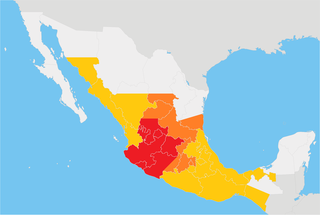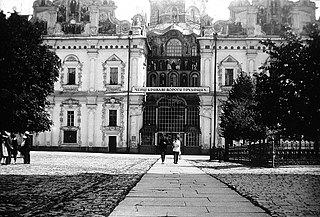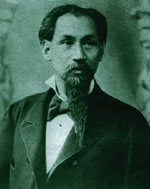Anti-clericalism is opposition to religious authority, typically in social or political matters. Historical anti-clericalism has mainly been opposed to the influence of Roman Catholicism. Anti-clericalism is related to secularism, which seeks to separate the church from public and political life.

The Constitution of Mexico, formally the Political Constitution of the United Mexican States, is the current constitution of Mexico. It was drafted in Santiago de Querétaro, in the State of Querétaro, by a constituent convention, during the Mexican Revolution. It was approved by the Constituent Congress on 5 February 1917. It is the successor to the Constitution of 1857, and earlier Mexican constitutions. "The Constitution of 1917 is the legal triumph of the Mexican Revolution. To some it is the revolution."

State atheism is the incorporation of positive atheism or non-theism into political regimes. It may also refer to large-scale secularization attempts by governments. It is a form of religion-state relationship that is usually ideologically linked to irreligion and the promotion of irreligion to some extent. State atheism may refer to a government's promotion of anti-clericalism, which opposes religious institutional power and influence in all aspects of public and political life, including the involvement of religion in the everyday life of the citizen. In some instances, religious symbols and public practices that were once held by religion were replaced with secularized versions. State atheism can also exist in a politically neutral fashion, in which case it is considered as non-secular.

The Cristero War, also known as the Cristero Rebellion or La Cristiada[la kɾisˈtjaða], was a widespread struggle in central and western Mexico from 1 August 1926 to 21 June 1929 in response to the implementation of secularist and anticlerical articles of the 1917 Constitution. The rebellion was instigated as a response to an executive decree by Mexican President Plutarco Elías Calles to strictly enforce Article 130 of the Constitution, a decision known as Calles Law. Calles sought to eliminate the power of the Catholic Church in Mexico, its affiliated organizations and to suppress popular religiosity.

Anti-Catholicism is hostility towards Catholics or opposition to the Catholic Church, its clergy, and/or its adherents. At various points after the Reformation, some majority Protestant states, including England, Prussia, Scotland, and the United States, turned anti-Catholicism, opposition to the Pope (anti-Papalism), mockery of Catholic rituals, and opposition to Catholic adherents into major political themes. The anti-Catholic sentiment which resulted from this trend frequently led to religious discrimination against Catholic communities and individuals and it occasionally led to the religious persecution of them Historian John Wolffe identifies four types of anti-Catholicism: constitutional-national, theological, popular and socio-cultural.
The Catholic Church and politics concerns the interplay of Catholicism with religious, and later secular, politics. Historically, the Church opposed liberal ideas such as democracy, freedom of speech, and the separation of church and state under the grounds that "error has no rights". Eventually accommodated these ideas and began to view religious liberty as a positive value during and after the Second Vatican Council.
The dechristianization of France during the French Revolution is a conventional description of the results of a number of separate policies conducted by various governments of France between the start of the French Revolution in 1789 and the Concordat of 1801, forming the basis of the later and less radical laïcité policies. The aim of the campaign between 1790 and 1794 ranged from the appropriation by the government of the great landed estates and the large amounts of money held by the Gallican Church to the termination of Christian religious practice and of the religion itself. There has been much scholarly debate over whether the movement was popularly motivated.
Antireligion is opposition to religion. It involves opposition to organized religion, religious practices or religious institutions. The term antireligion has also been used to describe opposition to specific forms of supernatural worship or practice, whether organized or not. The Soviet Union adopted the political ideology of Marxism–Leninism and by extension the policy of state atheism which opposed the growth of religions.

Throughout the history of the Soviet Union (1917–1991), there were periods when Soviet authorities brutally suppressed and persecuted various forms of Christianity to different extents depending on State interests. Soviet Marxist-Leninist policy consistently advocated the control, suppression, and ultimately, the elimination of religious beliefs, and it actively encouraged the propagation of Marxist-Leninist atheism in the Soviet Union. However, most religions were never officially outlawed.
After the October Revolution of November 7, 1917 there was a movement within the Soviet Union to unite all of the people of the world under Communist rule. This included the Eastern bloc countries as well as the Balkan States. Communism as interpreted by Vladimir Lenin and his successors in the Soviet government required the abolition of religion and to this effect the Soviet government launched a long-running campaign to eliminate religion from society. Since some of these Slavic states tied their ethnic heritage to their ethnic churches, both the peoples and their churches were targeted by the Soviets.
The Calles Law, or Law for Reforming the Penal Code, was a statute enacted in Mexico in 1926, under the presidency of Plutarco Elías Calles, to enforce restrictions against the Catholic Church in Article 130 of the Mexican Constitution of 1917. Article 130 declared that the church and state are to remain separate. To that end, it required all "churches and religious groupings" to register with the state and placed restrictions on priests and ministers of all religions. Priests and ministers were prohibited from holding public office, canvass on behalf of political parties or candidates, or inherit property from persons other than close blood relatives. President Calles applied existing laws regarding the separation of church and state throughout Mexico and added his own legislation.
The modern history of anticlericalism has often been characterized by deep conflicts between the government and the Catholic Church, sometimes including outright persecution of Catholics in Mexico.
Anacleto González Flores was a Mexican Catholic layman and lawyer who was tortured and executed during the persecution of the Catholic Church under Mexican President Plutarco Elías Calles.

The history of the Catholic Church in Mexico dates from the period of the Spanish conquest (1519–21) and has continued as an institution in Mexico into the twenty-first century. Catholicism is one of many major legacies from the Spanish colonial era, the others include Spanish as the nation's language, the Civil Code and Spanish colonial architecture. The Catholic Church was a privileged institution until the mid nineteenth century. It was the sole permissible church in the colonial era and into the early Mexican Republic, following independence in 1821. Following independence, it involved itself directly in politics, including in matters that did not specifically involve the Church.

The USSR anti-religious campaign of 1928–1941 was a new phase of anti-religious campaign in the Soviet Union following the anti-religious campaign of 1921–1928. The campaign began in 1929, with the drafting of new legislation that severely prohibited religious activities and called for an education process on religion in order to further disseminate atheism and materialist philosophy. This had been preceded in 1928 at the fifteenth Party congress, where Joseph Stalin criticized the party for failure to produce more active and persuasive anti-religious propaganda. This new phase coincided with the beginning of the mass collectivization of agriculture and the nationalization of the few remaining private enterprises.

The Catholic Church in Latin America began with the Spanish colonization of the Americas and continues up to the present day.
The question of whether Freemasonry is anticlerical is the subject of debate. The Catholic Church has long been an outspoken critic of Freemasonry, and some scholars have often accused the fraternity of anticlericalism. The Catholic Church forbids its members to join any Masonic society under pain of interdiction. Freemasons usually take a diametrically opposite view, stating that there is nothing in Freemasonry that is in any way contrary to Catholicism or any other religious faith.

Irreligion in France has a long history and a large demographic constitution, with the advancement of atheism and the deprecation of theistic religion dating back as far as the French Revolution. In 2015, according to estimates, at least 29% of the country's population identifies as atheists and 63% identifies as non-religious.

National League for the Defense of Religious Liberty was a Mexican Catholic religious civil rights organization formed in March 1925 that played a crucial role in the Cristero War of 1926 to 1929.
Anti-Christian sentiment or Christophobia constitutes the fear of, hatred of, or prejudice against Christians, the Christian religion, and/or its practices. Anti-Christian sentiment is sometimes referred to as Christophobia or Christianophobia, although these terms actually encompass "every form of discrimination and intolerance against Christians", according to the Council of European Episcopal Conferences.













